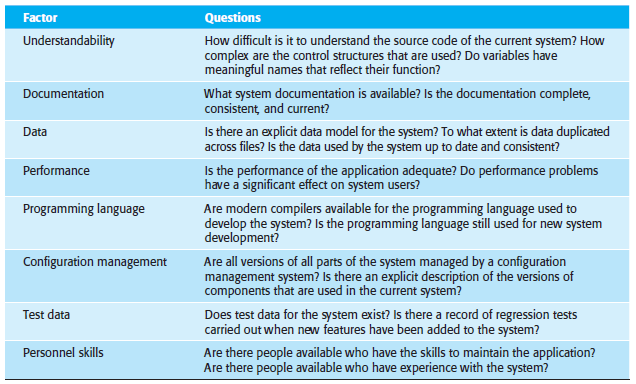Reference: Ian Sommerville, Software Engineering, 10 ed., Chapter 9
Note: The information provided here is an overview of the course notes provided by Dr. Stan Kurkovsky for Software Engineering
The big picture
There are many reasons why software change is inevitable:
- New requirements emerge when the software is used;
- The business environment changes;
- Errors must be repaired;
- New computers and equipment is added to the system;
- The performance or reliability of the system may have to be improved.
A key problem for all organizations is implementing and managing change to their existing software systems.
Organizations have huge investments in their software systems - they are critical business assets. To maintain the value of these assets to the business, they must be changed and updated. The majority of the software budget in large companies is devoted to changing and evolving existing software rather than developing new software. A spiral model of development and evolution represents how a software system evolves through a sequence of multiple releases.
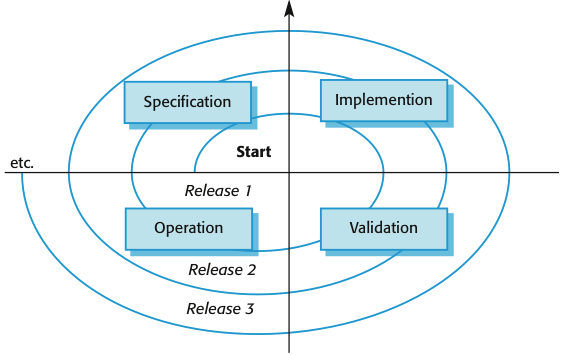
Rajlich and Bennett (Rajlich and Bennett 2000) proposed alternative view of the software evolution life cycle for business systems.

Evolution processes
Software evolution processes depend on:
- The type of software being maintained;
- The development processes used;
- The skills and experience of the people involved.
Proposals for change are the driver for system evolution. These should be linked with components that are affected by the change, thus allowing the cost and impact of the change to be estimated. Change identification and evolution continues throughout the system lifetime.

Change implementation can be viewed as an iteration of the development process where the revisions to the system are designed, implemented and tested. A critical difference is that the first stage of change implementation may involve program understanding, especially if the original system developers are not responsible for the change implementation. During the program understanding phase, you have to understand how the program is structured, how it delivers functionality and how the proposed change might affect the program.
Agile methods are based on incremental development so the transition from development to evolution is a seamless one. Evolution is simply a continuation of the development process based on frequent system releases. Automated regression testing is particularly valuable when changes are made to a system. Changes may be expressed as additional user stories.
Program evolution dynamics
Program evolution dynamics is the study of the processes of system change. The system requirements are likely to change while the system is being developed because the environment is changing, therefore a delivered system won't meet its requirements. Systems are tightly coupled with their environment. When a system is installed in an environment it changes that environment and therefore changes the system requirements. Systems MUST be changed if they are to remain useful in an environment.
After several major empirical studies, Lehman and Belady proposed that there were a number of 'laws' which apply to all systems as they evolved. They are sensible observations rather than laws. They are applicable to large systems developed by large organizations.
| Law | Description |
| Continuing change | A program that is used in a real-world environment must necessarily change, or else become progressively less useful in that environment. |
| Increasing complexity | As an evolving program changes, its structure tends to become more complex. Extra resources must be devoted to preserving and simplifying the structure. |
| Large program evolution | Program evolution is a self-regulating process. System attributes such as size, time between releases, and the number of reported errors is approximately invariant for each system release. |
| Organizational stability | Over a program's lifetime, its rate of development is approximately constant and independent of the resources devoted to system development. |
| Conservation of familiarity | Over the lifetime of a system, the incremental change in each release is approximately constant. |
| Continuing growth | The functionality offered by systems has to continually increase to maintain user satisfaction. |
| Declining quality | The quality of systems will decline unless they are modified to reflect changes in their operational environment. |
| Feedback system | Evolution processes incorporate multi agent, multi loop feedback systems and you have to treat them as feedback systems to achieve significant product improvement. |
Software maintenance
Software maintenance focuses on modifying a program after it has been put into use. The term is mostly used for changing custom software. Generic software products are said to evolve to create new versions. Maintenance does not normally involve major changes to the system's architecture. Changes are implemented by modifying existing components and adding new components to the system.
Types of software maintenance include:
- Maintenance to repair software faults: changing a system to correct deficiencies in the way meets its requirements.
- Maintenance to adapt software to a different operating environment: changing a system so that it operates in a different environment (computer, OS, etc.) from its initial implementation.
- Maintenance to add to or modify the system's functionality: modifying the system to satisfy new requirements.
-
Maintenance costs are usually greater than development costs (2x to 100x depending on the application). Costs are affected by both technical and non-technical factors; they tend to increase as software is maintained. Maintenance corrupts the software structure making further maintenance more difficult. Aging software can have high support costs (e.g. old languages, compilers etc.).
Maintenance cost factors include:
- Team stability: maintenance costs are reduced if the same staff are involved with them for some time.
- Contractual responsibility: the developers of a system may have no contractual responsibility for maintenance so there is no incentive to design for future change.
- Staff skills: maintenance staff are often inexperienced and have limited domain knowledge.
- Program age and structure: as programs age, their structure is degraded and they become harder to understand and change.
-
Maintenance prediction is concerned with assessing which parts of the system may cause problems and have high maintenance costs. Predicting the number of changes requires and understanding of the relationships between a system and its environment. Tightly coupled systems require changes whenever the environment is changed. Factors influencing this relationship are:
- Number and complexity of system interfaces;
- Number of inherently volatile system requirements;
- The business processes where the system is used.

Predictions of maintainability can be made by assessing the complexity of system components. Studies have shown that most maintenance effort is spent on a relatively small number of system components. Complexity depends on:
- Complexity of control structures;
- Complexity of data structures;
- Object, method (procedure) and module size.
-
Process metrics may be used to assess maintainability; if any or all of these is increasing, this may indicate a decline in maintainability:
- Number of requests for corrective maintenance;
- Average time required for impact analysis;
- Average time taken to implement a change request;
- Number of outstanding change requests.
-
System re-engineering refers to restructuring or rewriting part or all of a legacy system without changing its functionality. It is applicable where some but not all sub-systems of a larger system require frequent maintenance. Re-engineering involves adding effort to make them easier to maintain. The system may be restructured and re-documented.
Advantages of re-engineering include:
- Reduced risk: there is a high risk in new software development. There may be development problems, staffing problems and specification problems.
- Reduced cost: the cost of reengineering is often significantly less than the costs of developing new software.
Re-engineering process activities include:
- Source code translation: convert code to a new language;
- Reverse engineering: analyze the program to understand it;
- Program structure improvement: restructure automatically for understandability;
- Program modularization: reorganize the program structure;
- Data re-engineering: clean-up and restructure system data.
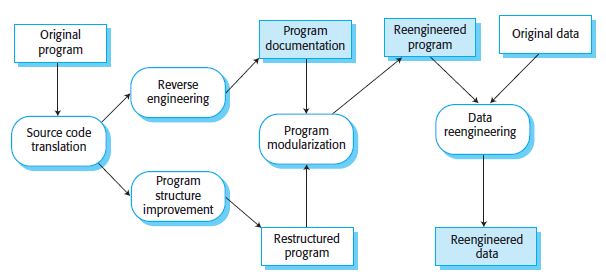
-
Refactoring is the process of making improvements to a program to slow down degradation through change. You can think of refactoring as 'preventative maintenance' that reduces the problems of future change.
Refactoring involves modifying a program to improve its structure, reduce its complexity or make it easier to understand. When you refactor a program, you should not add functionality but rather concentrate on program improvement. Re-engineering takes place after a system has been maintained for some time and maintenance costs are increasing. You use automated tools to process and reengineer a legacy system to create a new system that is more maintainable.
Refactoring is a continuous process of improvement throughout the development and evolution process. It is intended to avoid the structure and code degradation that increases the costs and difficulties of maintaining a system.
'Bad smells' of code are stereotypical situations in which the code of a program can be improved through refactoring:
- Duplicate code or very similar code may be included at different places in a program; it can be removed and implemented as a single method or function that is called as required.
- Long methods should be redesigned as a number of shorter methods.
- Switch (case) statements often involve duplication, where the switch depends on the type of a value or the switch statements may be scattered around a program. In object-oriented languages, you can often use polymorphism to achieve the same thing.
- Data clumping occurs when the same group of data items (fields in classes, parameters in methods) re-occur in several places in a program. These can often be replaced with an object that encapsulates all of the data.
- Speculative generality occurs when developers include generality in a program in case it is required in the future. This can often simply be removed.
Legacy system management
Most organizations have a limited budget for maintaining and upgrading their portfolio of legacy systems. They have to decide how to get the best return on their investment. This involves making a realistic assessment of their legacy systems and then deciding on the most appropriate strategy for evolving these systems. There are four strategic options:
- Scrap the system completely
- Leave the system unchanged and continue with regular maintenance
- Reengineer the system to improve its maintainability
- Replace all or part of the system with a new system
Organizations that rely on legacy systems must choose a strategy for evolving these systems. The chosen strategy should depend on the system technical quality and its business value:
- Low quality, low business value - (1,2,3): should be scrapped.
- Low-quality, high-business value - (9,10): make an important business contribution but are expensive to maintain. Should be re-engineered or replaced if a suitable system is available.
- High-quality, low-business value - (4,5): replace with Commercial Off-The-Shelf (COTS), scrap completely, or maintain.
- High-quality, high business value - (6,7,8): continue in operation using normal system maintenance.
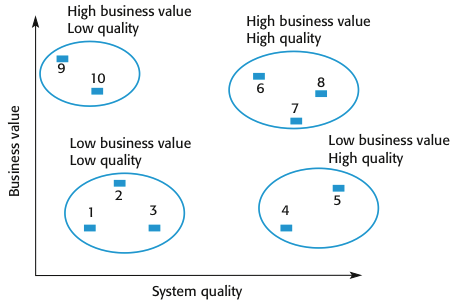
(1) Business value of the system
The business value of a system is a measure of how much time and effort the system saves compared to manual processes or the use of other systems. To assess the business value of a system, you have to identify system stakeholders, such as the end-users of a system and their managers, and ask a series of questions about the system. There are four basic issues that you have to discuss:
- The use of the system
- The business processes that are supported
- System dependability
- System outputs
(2) Technical perspective of the system
To assess a software system from a technical perspective, you need to consider both the (a) environment in which the system operates and the (b) application system technical quality.
(a) Environmental assessment
The environment includes the hardware and all associated support software such as compilers, debuggers and development environments that are needed to maintain the system. Factors for environment assessment consideration are:
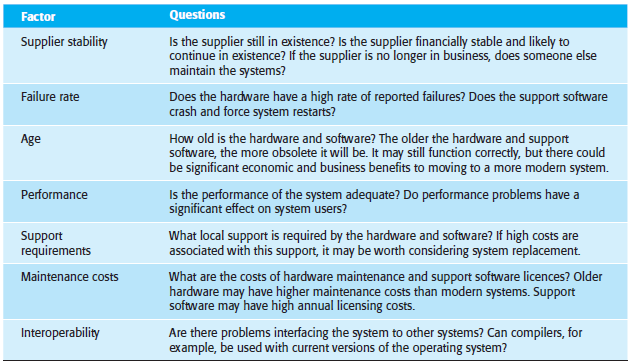
(b) Technical quality of the System
To assess the technical quality of an application system, you have to assess factors primarily related to system dependability, difficulties of maintaining the system, and system documentation. Some factors are:
- The number of system change requests
- The number of user interfaces
- The volume of data used by the system
A summary of the factors to assess application system technical quality are:
